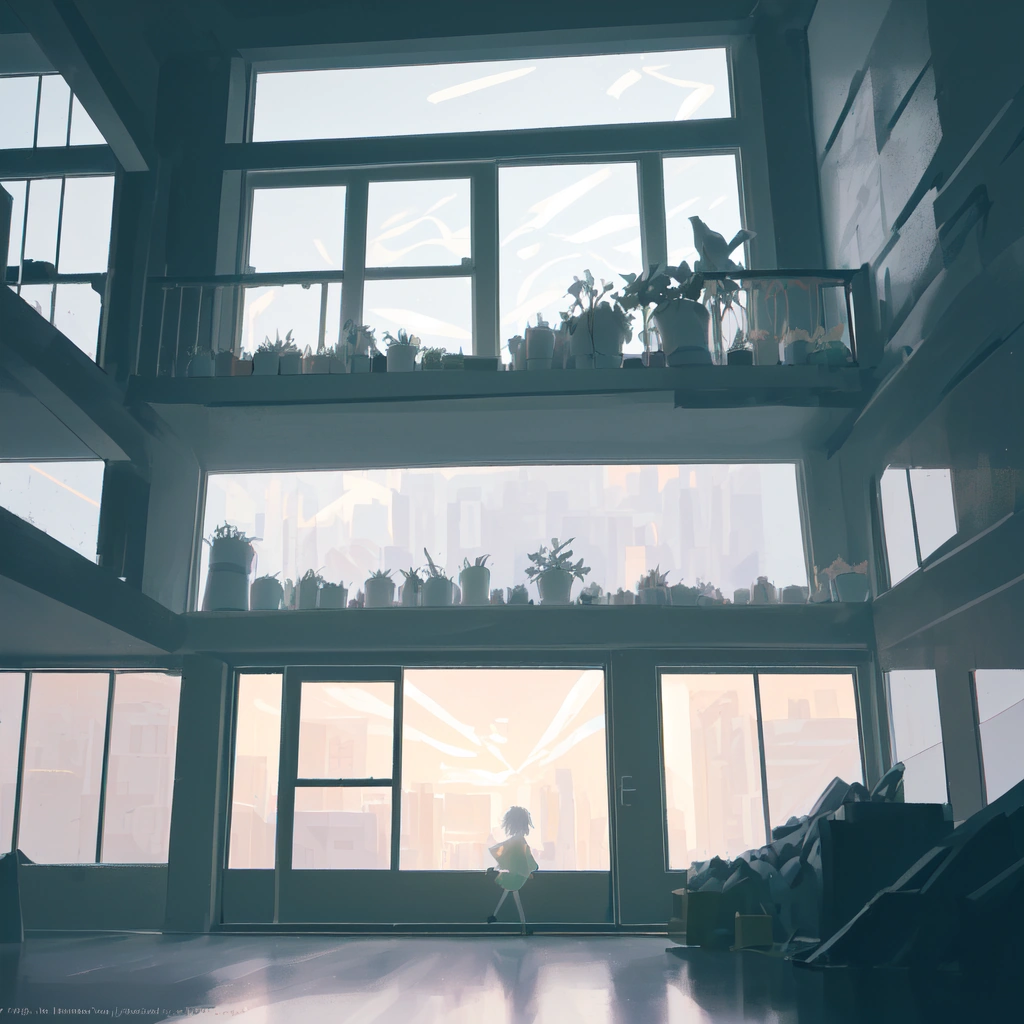Illuminating Interiors: How Large Windows Create an Open, Airy Home
The Allure of Light and Space: Reimagining Home Design
In an era where homes are increasingly becoming sanctuaries, the desire for spaces that breathe and inspire has never been stronger. Forget cramped quarters and dim interiors; the modern homeowner craves openness, a connection with the outdoors, and an abundance of natural light. One of the most impactful ways to achieve this transformative effect is through the strategic incorporation of large windows. More than mere architectural features, these expansive panes act as portals, blurring the lines between indoor comfort and the beauty of the natural world.
This article delves into the art and science of integrating large windows into your home’s design, unlocking the potential for an airy, light-filled haven. The allure of large windows extends beyond mere aesthetics; it’s a fundamental shift in how we perceive and interact with our living spaces. The integration of natural light through expansive glazing has been shown to improve mood, increase productivity, and even contribute to better sleep patterns. From a home renovation perspective, window replacement projects that prioritize larger, strategically placed windows can dramatically increase property value, appealing to buyers who seek open concept designs and a seamless indoor-outdoor flow.
Picture windows, for example, can transform a living room by creating a stunning focal point that captures breathtaking views, while carefully positioned bay windows can add depth and character to a dining area, flooding it with natural light. Furthermore, the incorporation of large windows is intrinsically linked to energy efficiency, a critical consideration for any modern home design. While the initial thought might be that larger windows lead to increased energy loss, advancements in window technology have made it possible to maximize natural light while minimizing heat transfer.
Energy-efficient windows, particularly those with low-E glass coatings and double- or triple-pane construction, significantly reduce the need for artificial lighting and lower heating and cooling costs. Careful consideration of window placement, taking into account solar orientation and shading, is also crucial for optimizing energy performance. Consulting with a window installation professional can help homeowners navigate these complexities and select the best energy-efficient options for their specific needs and architectural style. From an interior design standpoint, large windows serve as a dynamic backdrop, influencing everything from furniture placement to color palettes.
The abundance of natural light allows for the use of richer, more vibrant colors that might otherwise appear too dark or overwhelming in a dimly lit space. The architectural style of the home should inform the window design choices, ensuring a cohesive and harmonious aesthetic. For instance, a modern home might benefit from floor-to-ceiling windows that emphasize clean lines and minimalist design, while a traditional home could be enhanced with elegant bow windows that add a touch of classic charm. Thoughtful integration of window treatments, such as sheer curtains or automated shades, allows for control over light levels and privacy, further enhancing the functionality and beauty of the space.
Architectural Harmony: Matching Windows to Your Home’s Style
Before diving into the specifics of window selection, it’s crucial to consider the architectural style of your home. A modern, minimalist design lends itself beautifully to expansive floor-to-ceiling glass walls, creating a seamless transition to outdoor spaces and maximizing natural light. These large windows contribute to the open concept so often desired in contemporary home design. Conversely, a traditional or Victorian home might benefit from strategically placed bay or bow windows, which add character and architectural interest while maximizing light penetration and offering unique interior design opportunities.
Picture windows, often larger single-pane windows, can also be incorporated to frame specific views, but careful consideration of energy efficiency is paramount. The key is to ensure that the window design complements and enhances the existing aesthetic of the house. Beyond architectural style, the orientation of your home plays a significant role in determining the optimal window placement. South-facing windows will receive the most direct sunlight, potentially leading to increased heat gain in warmer months, but also providing passive solar heating in winter.
North-facing windows, on the other hand, offer softer, more diffused light, ideal for artists’ studios or rooms where consistent, glare-free illumination is desired. East-facing windows capture the invigorating morning sun, perfect for kitchens and breakfast nooks, while west-facing windows provide stunning sunset views but can also lead to significant afternoon heat gain. Strategic placement of energy-efficient windows, especially those with low-E glass, can mitigate these effects. Furthermore, consider the surrounding landscape and how window placement can integrate the interior with the exterior.
A well-placed picture window can transform a mundane room into a tranquil sanctuary by framing a beautiful garden or a breathtaking vista. Conversely, overlooking a busy street might necessitate the use of obscured glass or strategically placed landscaping to maintain privacy. Window replacement projects offer an excellent opportunity to reassess these factors and optimize window placement for both aesthetic appeal and functional benefits. Ultimately, the goal is to create an airy feel that connects the interior with the natural world while maintaining energy efficiency and privacy.
Consulting with an architect or experienced window installation professional is highly recommended to determine the optimal placement, size, and type of windows for your specific needs and home style. They can assess structural considerations, local building codes, energy efficiency requirements, and even advise on the best types of window frames to complement your home’s design. For example, a professional can guide you on selecting energy-efficient windows that meet specific climate zone requirements or recommend appropriate glazing options to minimize UV exposure and protect interior furnishings. Investing in professional guidance ensures that your window design not only enhances the beauty of your home but also contributes to its long-term value and comfort.
Energy Efficiency: Balancing Beauty with Practicality
While large windows offer undeniable aesthetic benefits, energy efficiency is a paramount concern when incorporating them into your home design. Opt for energy-efficient windows with low-E (low-emissivity) coatings, which reduce heat transfer by reflecting infrared and ultraviolet light, minimizing both unwanted heat gain during the summer and heat loss during the winter. This technology not only helps maintain a comfortable indoor temperature but also protects interior furnishings from fading caused by UV exposure. Double- or triple-paned windows provide superior insulation compared to single-pane options, creating a more effective barrier against temperature fluctuations and external noise.
For example, replacing single-pane windows with Energy Star-certified double-pane windows can reduce energy bills by up to 30%, depending on your climate zone. The initial investment in high-performance windows pays off over time through reduced energy consumption and increased home comfort. Consider argon or krypton gas fills between the panes for enhanced thermal performance. These inert, odorless, and non-toxic gases are denser than air, further reducing heat transfer through the window. The type of gas fill and the width of the airspace between the panes significantly impact the window’s U-factor, a measure of its insulation value.
Frame materials also play a significant role in overall energy efficiency. Vinyl frames are cost-effective, require minimal maintenance, and offer excellent insulation properties, making them a popular choice for window replacement projects. Wood frames offer a classic aesthetic and can be energy-efficient, especially when combined with proper weather stripping and insulation, but require regular upkeep to prevent rot and decay. Aluminum frames are durable and strong, making them suitable for large picture windows and modern designs, but can be less energy-efficient than vinyl or wood unless they incorporate thermal breaks to minimize heat transfer.
Fiber cement frames offer a good balance of durability, energy efficiency, and aesthetic appeal, resisting rot, insects, and fire. When planning window installation or window replacement, research Energy Star ratings and consult with a window specialist to select the most energy-efficient options for your climate and budget. The Energy Star program provides performance ratings for windows based on their U-factor, Solar Heat Gain Coefficient (SHGC), and air leakage, allowing homeowners to compare different products and make informed decisions.
Furthermore, consider the orientation of your home and the placement of large windows. South-facing windows, for instance, can provide significant solar heat gain during the winter, while east- and west-facing windows may require additional shading to prevent overheating during the summer. Integrating passive solar design principles with energy-efficient window choices can maximize natural light while minimizing energy consumption. Properly installed, energy-efficient windows can significantly reduce heating and cooling costs, enhance interior design by optimizing natural light, and contribute to a more sustainable and comfortable living environment, making them a worthwhile investment for any home renovation project seeking an open concept and airy feel.
Framing the View: Integrating Windows with Interior Design
Large windows not only enhance natural light, flooding interiors with brightness, but also frame captivating views, transforming them into living artwork. When planning window installation, meticulously consider the panorama you wish to capture. A sweeping view of a mountain range becomes a dramatic backdrop, a serene garden offers tranquility, while a bustling cityscape injects urban energy into your home design. Thoughtfully planned landscaping, incorporating elements like strategically placed trees or flowering shrubs, can further enhance the view and create a sense of privacy, particularly crucial in urban settings.
The goal is to curate a visual experience that complements and elevates your interior space. Picture windows, for example, are ideal for showcasing expansive landscapes, while bay windows can offer multiple perspectives and a cozy nook for enjoying the scenery. Interior design elements should seamlessly complement both the large windows and the view they provide, working in harmony to create an open concept and airy feel. Choose light, airy colors for walls and furnishings to maximize the effect of natural light, reflecting it throughout the room and enhancing the sense of spaciousness.
Avoid heavy, dark window treatments that block light and obscure the view, defeating the purpose of large windows. Instead, opt for sheer curtains, blinds, or shades that allow you to control light levels while maintaining a connection with the outdoors. Consider the orientation of your home; south-facing windows might benefit from shading solutions to mitigate glare during peak sunlight hours, while north-facing windows can embrace lighter, more transparent treatments. Mirrors, strategically placed, serve as powerful tools for amplifying natural light and expanding perceived space.
Position mirrors to reflect the view from your large windows, effectively bringing the outdoors in and creating an even greater sense of spaciousness. Beyond aesthetics, consider the energy efficiency implications of your window choices. Opt for energy-efficient windows with low-E glass coatings to minimize heat transfer and reduce glare, contributing to lower energy bills and a more comfortable indoor environment. When considering window replacement, explore options like double- or triple-paned windows with argon or krypton gas fills for superior insulation. By carefully balancing aesthetics with practicality, you can create a home that is both beautiful and sustainable. The architectural style of your home should also inform your window choices; for instance, modern homes often benefit from minimalist window designs that maximize glass area, while traditional homes might incorporate bay windows or bow windows for added character and charm.
The Bright Future of Home Design: Embracing Natural Light
Incorporating large windows into your home’s design transcends mere renovation; it’s a transformative investment that fundamentally enhances the quality of your living space and overall well-being. By thoughtfully considering architectural style, prioritizing energy efficiency, and seamlessly integrating window design with interior design principles, you can cultivate an open, airy feel that blurs the lines between indoors and out. This holistic approach not only maximizes natural light, creating a brighter and more inviting ambiance, but also elevates the aesthetic appeal of your home, potentially increasing its market value.
Remember that the success of this endeavor hinges on meticulous planning and professional execution. When embarking on a home renovation project involving large windows, particularly a window replacement or the installation of new picture windows, prioritize energy-efficient windows to mitigate potential drawbacks. Opt for windows with low-E glass coatings, which selectively filter solar radiation, reducing heat gain in the summer and heat loss in the winter. Double- or triple-paned windows, often filled with argon or krypton gas, provide superior insulation, further minimizing energy consumption.
These features contribute to a more comfortable and sustainable living environment, reducing your carbon footprint and lowering utility bills. Selecting the right energy-efficient windows is a crucial step in ensuring that your investment yields long-term benefits. Beyond energy efficiency, the strategic placement and style of large windows play a pivotal role in shaping the interior design and architectural harmony of your home. For example, bay windows or bow windows can add a touch of elegance and expand the perceived space in a traditional home, while floor-to-ceiling glass walls can create a seamless transition between indoor and outdoor living in a modern open concept design.
The framing material also matters – wood frames offer a classic, warm aesthetic, while aluminum or vinyl frames provide durability and low maintenance. Consider the views you wish to capture – a panoramic vista, a serene garden, or a vibrant cityscape – and tailor your window design to maximize their impact. Thoughtful landscaping can further enhance these views, creating a cohesive and visually stunning environment. Finally, remember that proper window installation is paramount to ensuring optimal performance and longevity.
Consult with certified window installation professionals who possess the expertise to ensure compliance with local building codes and manufacturer specifications. Improper installation can lead to air leaks, water damage, and structural issues, negating the benefits of even the most energy-efficient windows. With careful planning, professional execution, and a keen eye for detail, large windows can become a defining feature of your home, creating a bright, inviting, and inspiring environment for years to come, while simultaneously enhancing its value and sustainability.


